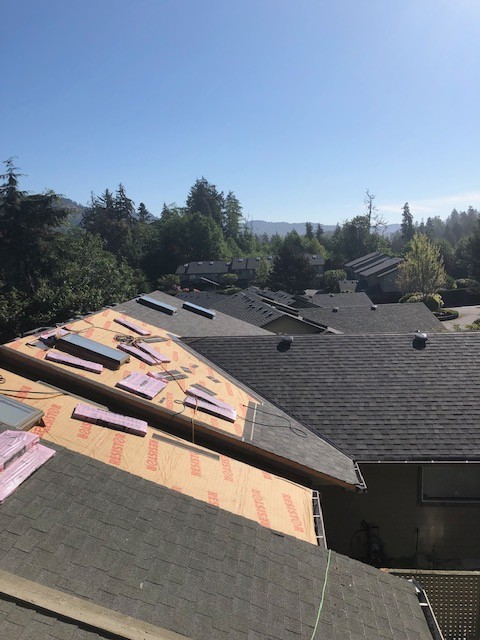Shingles are a thin piece of building material manufactured for use on roofs and sometimes siding on homes. Cedar and fiberglass shingles are shaped with a thicker butt end. They are typically installed in overlapping rows.
Cedar wood is locally sourced on Vancouver Island. In the manufacturing of asphalt shingles, fiberglass has a fiberglass mat as opposed to regular asphalt shingles made with a paper base.
When it comes to choosing cedar shingles versus fiberglass shingles, there are several key features and facts to take into consideration.
COST
- Cedar shingles are typically one of the more expensive roofing materials to have installed. However, with ever-changing manufacturing and delivery costs, it is best to contact a professional roofing company for a current quote on both cedar and fiberglass shingles. That way you will have an accurate cost comparison on both materials, along with installation rates.
- Climate change is a hot topic these days for energy efficient builds. Fiberglass shingles are manufactured with a technology that helps reduce the amount of heat absorption on the roof, thereby reducing cooling costs in the home over the summer months.
DESIGN
- Cedar has a natural, warm look that blends in perfectly with natural surroundings.
- Cedar shingle roofing makes for an idyllic traditional design.
- Every cedar shingle is unique in that each one comes from a split log with varying thickness and lengths.
- Fiberglass shingles look identical to traditional asphalt shingles; however, they can be pricier.
- Homeowners have several options with fiberglass roofing since they come in varying styles that allow for visually stunning designs. For example, fiberglass shingles can be made to look like wood shakes or slate tile roofing, but at a lower cost.
LONGEVITY
- Stained cedar shingles last longer than untreated shingles.
- Under ideal conditions, skilled installation, and regular maintenance, treated wood shingles can last 30 years.
- On the other hand, cedar shingles may be damaged sooner when exposed to excessive rainfall.
- However, cedar is naturally resistant to insect infestations.
- Cedar shingles can be treated with fire retardant to increase durability.
- Wood shingles are impact-resistant and can withstand high winds.
- Fiberglass shingles are impact, fire, and water resistant and work well in hotter climates.
- However, fiberglass shingles are prone to cracking in extremely cold climates.
- Depending on proper installation and maintenance, fiberglass shingles can last 25-50 years.
- Whatever type of shingle you select, it is important to choose the best quality product you can afford and have them installed properly.
MAINTENANCE
- Care for cedar shingles is extensive compared to other roofing and siding material. Since wood needs to breathe, the roof must be cleared continually of debris such as tree branches and leaves.
- Cedar roofing must have regular moss-removal every 2-4 years as well to avoid premature damage.
- Thinner, lighter fiberglass shingle roofing should be inspected after heavy storms or icing for cracks. Shingles must be repaired or replaced before extreme fissures occur.
There are many options for roofing on the market today. Cedar shake roofing is typically the choice for a traditional home style build, whereas fiberglass shakes are a more modern design option.
Choosing a good roofing contractor is essential to having shingles installed correctly so they last. The experts at Shoreline Roofing & Exteriors in Victoria, BC have countless shingle installations under their belts and book up quickly. Don’t hesitate to get in touch with us today for professional help in assessing which shingle is right for your home.

